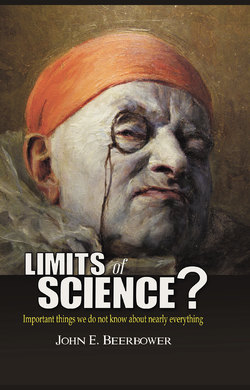Читать книгу Limits of Science? - John E. Beerbower - Страница 4
На сайте Литреса книга снята с продажи.
The Goal of Comprehension
ОглавлениеInitially, in thinking about how we know things, it is probably common to seize upon the distinction between direct sensory perceptions and knowledge from inference or deduction. We feel a solid surface; we see a star; we hear the waves; we taste and smell the ripe fruit. However, as a result of the discoveries of science, we can all appreciate how tenuous that distinction really is. Surfaces are not solid, but composed of molecules the volume of which is only a small part particles, part energy and a lot of nothing (even though, from most viewpoints relevant to normal existence and daily functioning, surfaces are still solid); some of the stars we see are no longer there and have not existed for thousands or even millions of years; sound consists of vibrations or waves transmitted through the air that have significance because of their impact on our eardrums; we can smell because our receptors react to molecules floating through the air. And sight? Photons activate the receptors that feed the optical nerve.
Then, of course, to be complete, one still needs to examine the next level: how the physical stimuli of our nerves and receptors are transmitted to and, more importantly, “interpreted” by our brain. Indeed, as we shall discuss in a later chapter, it is the brain, not the sensory organs, that perceives the physical world. Moreover, the functioning of the brain is frighteningly complex and, it seems, in some ways counter-intuitive.
It is a different aspect of mental activity that I want to discuss now, however. It seems accepted wisdom that we interpret or understand things about ourselves only through the use of models and theories. In other words, sensory perceptions or other “information,” apart from that which generates an instinctive response, can be processed only through theories we hold about how the world around us functions. We are not objective, neutral observers; instead, we absorb information through the organizing filters of preconceptions about causality and other relationships. Obviously, we can learn and our preconceptions—the models and theories that we utilize—can and do change over time. The point is that we could not function in a human capacity without such models and theories.
We can achieve some expectations and some sense of causal relationships through observation and induction—the drawing of inferences from a series of individual observations. For example, there has been extensive use of surveys or experimental collections of data in connection with medical science and the study of health issues. These studies are classic opportunities for inductive and probabilistic reasoning. We find a significant statistical correlation between certain environmental or behavioral characteristics and certain health characteristics in a population. That statistical correlation suggests that there may be a more substantive relationship. And, it may or may not, in fact, be a causal relationship. However, to address that underlying question of causality, one generally needs to develop an explanatory theory as to how and why the two phenomena relate to one another.
Albert Einstein reportedly remarked that “The most incomprehensible thing about the physical world is that it is comprehensible.” Quoted by, inter alia, Lord Rees, From Here to Infinity, p.80; Stephen Hawking and Leonard Mlodinow, The Grand Design (2010), p.87. Comprehensibility depends first upon the existence of certain regularities in the physical world that allow us to generalize. If knowledge of the physical world required specific or unique information about each atom or constituent piece of the world, then the magnitude of the data required would clearly exceed the capacity of the human brain, and we could never know the world. See Carl Sagan, Broca’s Brain, p.16. However, it just so happens that there are substantial uniformities, regularities and patterns, so that much of the physical world can be accurately described in a relatively small amount of information.
Some of the more interesting of these regularities are often referred to as “laws of nature.” We shall talk more about that concept later. But, I think that something more subtle and intriguing is encompassed in Einstein’s reference to comprehensibility. In part, his comment undoubtedly reflected the surprising ability of mathematics to be used to predict physical events, which I discuss below. In part, the comment also likely captured this other concept of insight or understanding—not just that we have tools that predict accurately, but that we have explanatory theories that seem to make the relationships make sense, i.e., be comprehensible.
It is not clear that there is any reason why the ability of the human mind to “understand” physical phenomena would necessarily have any direct correlation with the actual physical relationships that exist, except that the species would probably not have survived if the mental constructs (or models) of which we were capable veered too dramatically away from the actual environmental facts. At the same time, by such reasoning, that apparent conformity need only extend to matters relevant to our existence, specifically to our survival and reproduction. It may be that human cognition is capable of no more than relatively superficial comprehension of our Universe, so that the deeper truths (those not directly related to our survival, at least not yet) are simply beyond our ability to comprehend. We shall encounter that possibility from time to time below.
